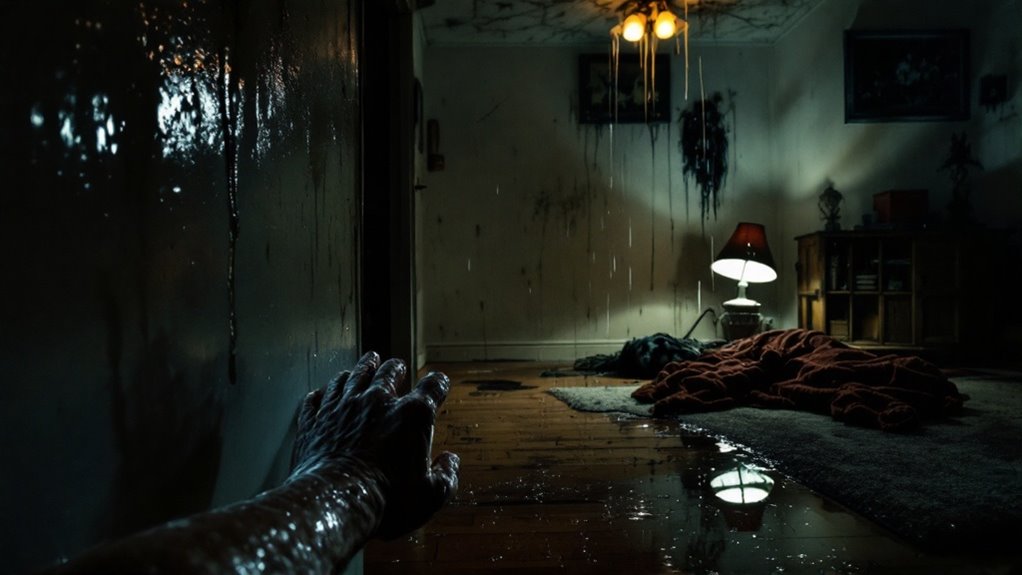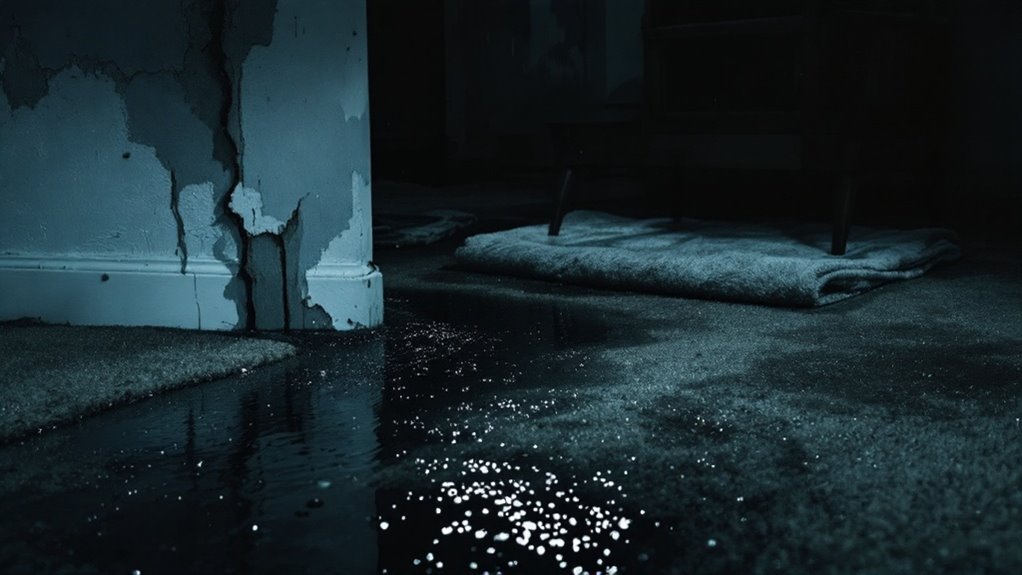Waking up to the sound of dripping water at 2 AM can be unsettling. You need to act fast to minimize damage and protect your home. First, assess the situation and locate the source of the leak. It’s crucial to stay calm and focus on what to do next. Knowing the right steps to take can make all the difference in preventing a minor issue from becoming a major disaster. So, what’s your next move?
Key Takeaways
- Identify the source of the water damage by listening for dripping sounds and checking for visible leaks or wet spots.
- Turn off electricity to prevent hazards, especially near water, by switching off the main power or circuit breakers.
- Remove valuable items from the affected area promptly to minimize damage and transport them to a dry location.
- Use towels or mops to soak up excess water and document damage for insurance claims with photos and lists of affected items.
- Increase airflow by opening windows and using fans or dehumidifiers to expedite the drying process and prevent mold growth.
Assess the Situation

When you wake up to the sound of water dripping at 2 AM, it’s essential to evaluate the situation quickly. First, listen carefully to pinpoint the source of the noise. Is it a leaky pipe, an overflowing sink, or something else? Next, check for visible signs of water pooling or wet spots on the floor and walls. If it’s safe, inspect the area closely to determine the severity. You’ll want to note any potential damage to your belongings, as well. Evaluating the situation helps you understand what you’re dealing with before taking further action. Additionally, be aware that excess moisture can lead to mold growth, which poses health risks if not addressed promptly. Staying calm and focused allows you to make well-informed choices, ensuring you can effectively tackle the problem before it escalates.
Shut Off the Water Supply
After evaluating the situation, your next step is to shut off the water supply. Locate the main shut-off valve, usually found near your water meter or where the water line enters your home. Turn the valve clockwise to stop the flow. If you can’t find the main valve, check for individual shut-off valves connected to appliances like sinks, toilets, and washing machines. Turning these off can help minimize damage until you address the larger issue. Make sure to keep track of any leaks or damaged areas for future repairs. Once the water’s off, you can focus on drying out the affected areas and determining further actions. Staying calm during this process is essential for effective management. Additionally, consider contacting an emergency plumbing service for professional assistance with any urgent repairs.
Turn Off Electricity if Necessary

If water is seeping near electrical outlets or appliances, it’s crucial to turn off the electricity immediately. Water conducts electricity, posing a serious risk of shock or fire. Locate your circuit breaker or fuse box and switch off the power to the affected areas. If you’re unsure which circuit to turn off, it’s safer to shut down the main power. Always use dry hands and stand on a dry surface when handling the breaker. Once the electricity is off, avoid touching any wet surfaces or appliances, as they may still be live. Remember, your safety comes first. Once the area is secure, you can start addressing the water damage without the fear of electrical hazards. Additionally, contacting a 24 Hour Plumbing Service can provide immediate assistance for any urgent plumbing issues that may arise from the water damage.
Remove Valuable Items and Furniture
As you assess the damage, prioritize removing valuable items and furniture from the affected area. Every moment counts when it comes to minimizing loss. Carefully consider what holds the most sentimental or monetary value, and act swiftly.
| Item Type | Emotional Value |
|---|---|
| Family Photos | Priceless Memories |
| Heirloom Jewelry | Family Legacy |
| Electronics | Daily Connection |
| Furniture | Comfort & Security |
| Artwork | Personal Expression |
Contain the Water

To contain the water, you first need to identify the source of the leak. Grab some towels and buckets to soak up the water, and try to seal off the affected areas to prevent further damage. Taking these steps quickly can make a big difference in minimizing the impact of the water intrusion.
Identify the Source
Where’s that water coming from? To tackle water damage effectively, you need to pinpoint the source right away. Check for visible leaks from pipes, appliances, or your roof. If you notice water pooling near a certain area, that’s your first clue. Don’t forget to inspect less obvious places like behind walls or under sinks. If you can’t identify the source quickly, listen for dripping sounds or watch for water stains that could indicate where the issue lies. Once you find the culprit, turn off the water supply to minimize damage. Remember, the sooner you act, the better you can control the situation and prevent further complications. Stay focused, and don’t panic; you’ve got this!
Use Towels and Buckets
Once you’ve identified the source of the water, it’s crucial to contain the situation quickly. Start by gathering towels and buckets to minimize damage. Here’s what you should do:
- Soak Up Excess Water: Use towels to soak up as much water as possible. Wring them out frequently to maximize absorption.
- Place Buckets Strategically: Position buckets under leaks or drips to catch any ongoing water. This prevents further spread.
- Create a Barrier: If the water is spreading, use towels as a barrier to slow its movement toward dry areas.
- Check for Electrical Hazards: Confirm you’re aware of any electrical outlets nearby, and avoid standing water in those areas.
Taking these steps can help control the situation until further action is possible.
Seal Off Affected Areas
After soaking up excess water and using buckets to catch any ongoing drips, it’s time to seal off the affected areas to prevent further damage. Start by closing doors and windows to limit airflow, which can spread moisture. If possible, use plastic sheeting or tarps to cover openings, especially if there’s a risk of more water intrusion. Turn off any HVAC systems to stop the circulation of moist air. If you have furniture or belongings in the area, move them to a dry space to avoid additional damage. Finally, stay vigilant and monitor the situation. The quicker you contain the water, the better chance you have of minimizing damage and speeding up the recovery process.
Document the Damage
As you assess the situation, documenting the damage becomes essential for understanding the extent of the destruction caused by the water intrusion. This step will likewise help you when dealing with insurance claims. Here’s how to do it effectively:
- Take Photos: Capture clear images of the affected areas from multiple angles.
- List Damaged Items: Write down all damaged belongings, including furniture and appliances.
- Record Water Levels: Note how high the water reached, as this can indicate potential structural damage.
- Collect Receipts: Gather any receipts for repairs or emergency services you’ve already incurred.
Contact a Professional Restoration Service
With a clear understanding of the damage, your next step is to contact a professional restoration service. These experts have the tools and experience to address water damage quickly and effectively, minimizing further issues. When you call, they’ll assess the situation, create a plan, and begin work immediately.
Here’s a quick guide to help you choose a service:
| Aspect | Importance |
|---|---|
| Response Time | Quick response helps prevent further damage. |
| Experience & Certification | Guarantees quality and safety in restoration. |
| Customer Reviews | Positive feedback indicates reliability. |
Prevent Future Incidents
To prevent future incidents of water damage, it’s crucial to take proactive measures in maintaining your home. Regular upkeep can save you from costly repairs down the line. Here are four key steps you should consider:
- Inspect Plumbing: Regularly check for leaks in pipes, faucets, and toilets. Fix any issues immediately to avoid larger problems.
- Clean Gutters: Verify your gutters and downspouts are clear of debris. This helps direct water away from your foundation.
- Monitor Humidity: Use dehumidifiers in damp areas like basements to keep moisture levels low.
- Seal Windows and Doors: Check weather stripping and caulking to prevent water seepage during storms.
Implementing these steps can greatly reduce your risk of future water damage.
Conclusion
In the chaos of water damage at 2 AM, staying calm and taking swift action is crucial. By evaluating the situation, shutting off utilities, and removing valuables, you can minimize the impact. Don’t forget to document everything for insurance purposes. If the damage is extensive, reaching out to a professional restoration service can save you time and stress. After this experience, wouldn’t you want to guarantee your home is protected against future water issues?
